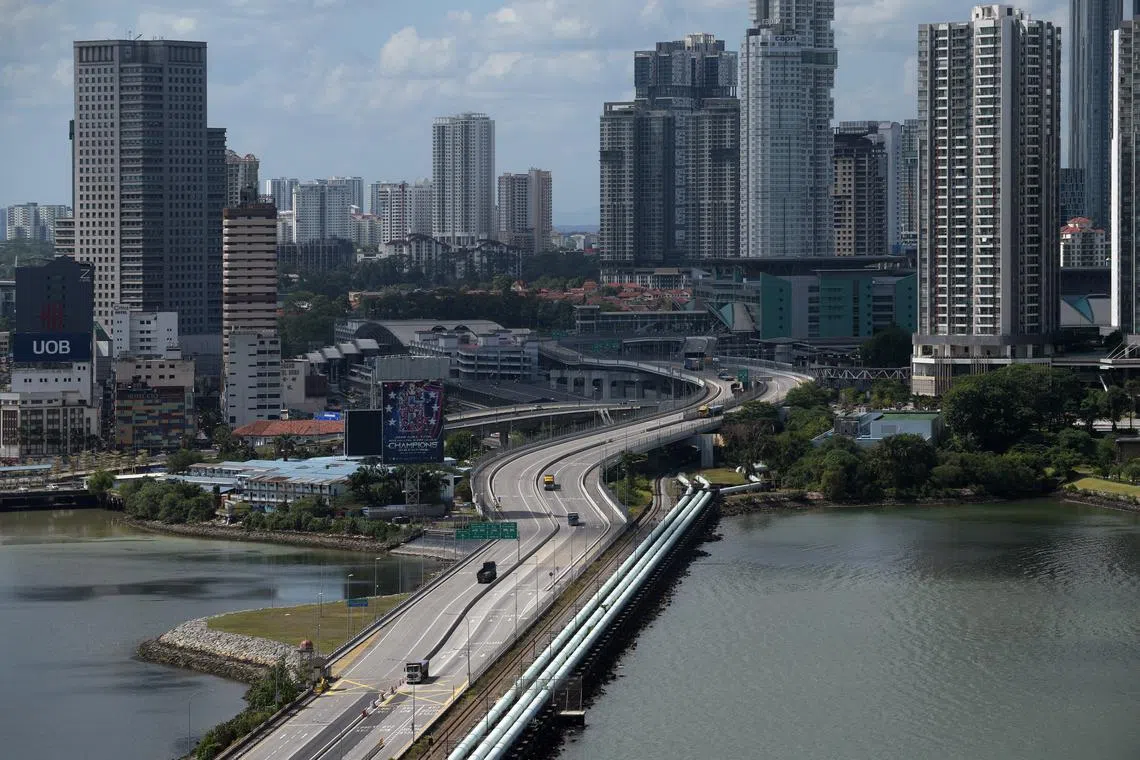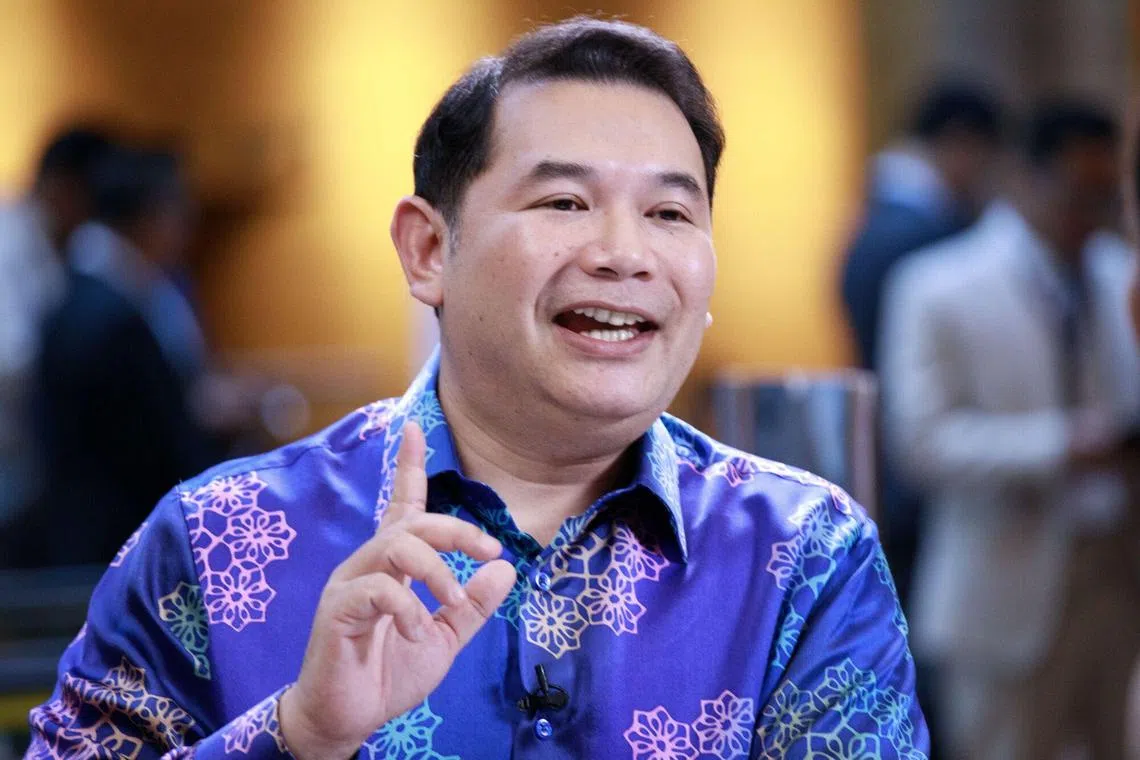Johor set for $38b economic boost from Johor-Singapore SEZ by 2030
Sign up now: Get ST's newsletters delivered to your inbox

The JS-SEZ agreement states that Malaysia would design an infrastructure fund for the zone, and Singapore a facilitation fund.
PHOTO: ST FILE
Follow topic:
KUALA LUMPUR – Johor is expected to rival the Klang Valley as Malaysia’s economic engine within the next decade, thanks to a projected US$28 billion (S$38 billion) boost in gross domestic product from the newly agreed upon Johor-Singapore Special Economic Zone (JS-SEZ).
Malaysia’s Economy Minister Rafizi Ramli told The Straits Times that this quantum of growth is expected by 2030, based on the target of 50 new high-value projects to be located in the zone in the next five years.
“If you put into your model all the spillover effects, if one project (investment value) is about RM3 billion (S$912 million) to RM4 billion…that’s already RM150 billion,” he explained in a Jan 9 interview.
The JS-SEZ agreement, signed on Jan 6 in conjunction with the recent Malaysia-Singapore Leaders’ Retreat in Putrajaya,
The huge projected economic boost will partly be due to investors in the new special economic zone being able to structure their businesses to take advantage of the lower trade barriers of either nation, as part of efforts to “reduce friction between operating in Singapore and Johor”, Mr Rafizi said.
The impending return of President-elect Donald Trump to the White House has raised concerns of sweeping tariffs, especially against nations that run a trade surplus with the US.
However, businesses in the JS-SEZ could design their operations to tap Singapore’s free trade agreement with Washington, said Mr Rafizi.
“Singapore has advantages in terms of access that we don’t have. I imagine as we go along, we will come across creative ways (in which) businesses will present how they want to structure,” he said during the interview on the sidelines of the Malaysian Economic Forum (MEF).
He also clarified that while there was no announcement after the signing, the JS-SEZ agreement states that Malaysia would design an infrastructure fund for the zone, and Singapore a facilitation fund. Malaysia will build roads, utilities and other necessities for new projects in the zone, while the Republic will offer financial support to help Singapore firms expand and multinational companies “twin” in the JS-SEZ and Singapore.
“It’s left to each government to decide the quantum to move in tandem with the prospective investments. Malaysia has started with RM5 billion (as per Budget 2025),” he said.
Although it has taken a year to go from a memorandum of understanding to a signed agreement, Mr Rafizi said the next six months are going to be “very hectic” as more details have to be ironed out.

Malaysian Economy Minister Rafizi Ramli said the next six months are going to be “very hectic” as more details on the Johor-Singapore Special Economic Zone have to be ironed out.
PHOTO: BLOOMBERG
First, the existing Joint Ministerial Committee for Iskandar Malaysia will now be repurposed to steer the JS-SEZ, which includes areas outside the existing Iskandar catchment.
The three main areas in the new zone that were not in the Iskandar region in southern Johor are Pengerang district on the south-east coast of the state, Desaru, and the Forest City reclamation project.
“We will now finalise blueprints for the nine nodes to be developed and agreed by both countries. Then there will be clarity for investors to come in. We must hit the ground running (so) some of the investment decisions can already be announced in the space of 12 months,” Mr Rafizi said.
On a separate issue, Mr Rafizi said he agreed with Finance Minister II Amir Hamzah Azizan’s assertion at an MEF panel discussion earlier on Jan 9 that the government’s plan to remove petrol subsidies in Malaysia by mid-2025 remained on the cards.
Datuk Seri Amir said during the discussion that the June 2024 removal of subsidies for diesel,
Even though cutting subsidies is a deeply unpopular move in Malaysia, Mr Rafizi at the interview insisted that such reforms were not just about fiscal savings, but also to restructure the economy.
“Subsidy bill saving is not the overriding objective. It’s not purely to balance the books. It’s about the leakages and consumption patterns,” he said.
He cited as an example the need to move towards more sustainable forms of energy. “The target for electric vehicle adoption is 80 per cent by 2050. But it’s quite difficult if the substitute (fossil fuels) is a lot cheaper,” he said.
Mr Rafizi said the removal of fuel subsidies “has become a bellwether gauge of the government’s reform credentials”.
“It is considered the most difficult, and politicians think you will lose the election (if you do so). To us, it’s quite central to the government’s economic reforms.”
He also pointed out that the decision between using direct cash transfers and having tiered pricing at fuel stations in order to distribute the fuel subsidies would have a knock-on effect on annual inflation, which the government wants to keep under 2 per cent.
The government has said it will ensure that 85 per cent of the population with lower net disposable income will retain their petrol subsidies.
Shannon Teoh is The Straits Times’ bureau chief for Malaysia, where he has reported on various beats since 1998.


